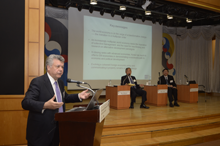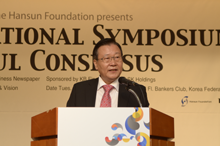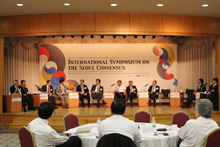Seoul Consensus 2 – Development Strategies for the Least Developed Nations
- 1. To globalize to the greatest extent possible because every country's successful economic development was the result of
a shift toward globalization - 2. To establish these essential elements: political stabilization; strong national leadership; and excellent government
officers - 3. To induce investments for human resource development, such as education as much as possible
- 4. To encourage people to dream and to feel confident about the future because people's patriotism and national identity is
a key driver for development through better governance. - 5. To have insure that the national government has in place an effective, integrated plan for growth including plans for
economic development, industrial policies, human capital development and more. - 6. To design all policies with clear incentives to utilize the "carrot and stick" method.
- 7. To reduce political and economic corruption as much as possible
- 8. To have enough export oriented strategies, to maintain an adequate amount of foreign exchange holdings in order to
prepare for the increasing instability of global markets. - 9. To utilize actively financial globalization by attracting foreign direct investment as much as possible, yet maintaining
appropriate regulations for short term debt - 10. To offer target performance management in cooperation with the public and private sector to maximize growth.
At the beginning of the year 2010, the Hansun Foundation published introductory articles about the Seoul Consensus serially in a daily newspaper, The Chosun Ilbo in a partnership with the newspaper company. In September 2011, we published a book, with compiled research results and also held an international symposium on the topics of the book.
The research includes:

21st Century Korea's Mental Capital Future Development
21st Century Human Capital and Economic Development
21st Century version of Economic Strategies
Reform of Higher Education to Lead the Knowledge Ecosystem
Seeking a New Welfare Policy
Reform of National Leadership and Political Parties
Decentralized governance system
Blueprint of East Asia and Reunification of Korean Peninsula
Strategies for Korea's Contribution to the World and for New Development Strategies Methodology and Implementation System



 The Washington Consensus, first proposed by economist John Williamson of the Institute for International Economics in 1989, has been a dominant development paradigm for the two decades. It is based on neo-liberalism and is guided by three overriding principles: (1) Stabilization of the macro economy; (2) Opening of economies and economic liberalization, a pretentious phrase which means deregulation of banks and markets. (3) Privatization of state-owned Companies. Originally conceived as a panacea for the economies of Third World countries, it was hastily distorted by special interests. Its validity lost considerable trust in its relevancy to the real world when at least some of those policy recommendations resulted in a global recession in 2008. After that, the Barcelona Agenda (2004) was suggested as an alternative model but was not quite welcomed. Also, the Beijing Consensus (2004) has a limit to its applicability for others because it is based on a centrally controlled socialist economy.
The Washington Consensus, first proposed by economist John Williamson of the Institute for International Economics in 1989, has been a dominant development paradigm for the two decades. It is based on neo-liberalism and is guided by three overriding principles: (1) Stabilization of the macro economy; (2) Opening of economies and economic liberalization, a pretentious phrase which means deregulation of banks and markets. (3) Privatization of state-owned Companies. Originally conceived as a panacea for the economies of Third World countries, it was hastily distorted by special interests. Its validity lost considerable trust in its relevancy to the real world when at least some of those policy recommendations resulted in a global recession in 2008. After that, the Barcelona Agenda (2004) was suggested as an alternative model but was not quite welcomed. Also, the Beijing Consensus (2004) has a limit to its applicability for others because it is based on a centrally controlled socialist economy. In 2009, the "Seoul Consensus: 21st Century New Development Paradigm" was suggested as a result of intense discussions and debates of 70 experts from various areas. The purpose of the Seoul Consensus (2010) was to provide a new, workable model for a world confused by the economic chaos created during the previous two years. The question remained: how to promote a nation's economic growth with a new development model that would create an economic paradigm shift.
In 2009, the "Seoul Consensus: 21st Century New Development Paradigm" was suggested as a result of intense discussions and debates of 70 experts from various areas. The purpose of the Seoul Consensus (2010) was to provide a new, workable model for a world confused by the economic chaos created during the previous two years. The question remained: how to promote a nation's economic growth with a new development model that would create an economic paradigm shift.

